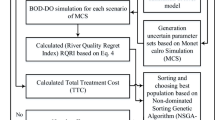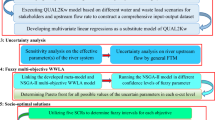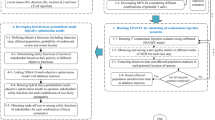Abstract
In this paper, we developed a simulator-optimizer model based on risk analysis to determine Waste Load Allocation (WLA). A new Fuzzy index as Fuzzy Risk Index (FRI) was linked with multi-objective optimization to minimize FRI for the environmental stakeholder and the total cost of sewage treatment for the polluting industries as the other collective stakeholder. Afterwards, the conflict was resolved with the help of Nash bargaining and bankruptcy approach (Constrained Equal Awards Rule). The model was run using quantitative/qualitative data for the KhoramAbad River. To check the efficiency of FRI, the process followed for WLA was reimplemented by the Monte Carlo simulation (MCS). A comparison between the two approaches revealed that the outcomes derived from Fuzzy arithmetic across all aspects, encompassing river qualitative simulation, nondominated curve, Nash bargaining’s agreed point, and bankruptcy output, closely mirrored the results of MCS. The notable distinction lies in the drastic reduction of the model’s execution time by a factor of 450.








Similar content being viewed by others
Data availability
The datasets generated during and/or analyzed during the current study are available from the corresponding author on reasonable request.
References
Aghasian, K., Moridi, A., Mirbagheri, A., & Abbaspour, M. (2019). A conflict resolution method for waste load reallocation in river systems. International Journal of Environmental Science and Technology, 16, 79–88.
Ahmadisharaf, E., Camacho, R. A., Zhang, H. X., Hantush, M. M., & Mohamoud, Y. M. (2019). Calibration and validation of watershed models and advances in uncertainty analysis in TMDL studies. Journal of Hydrologic Engineering, 24(7), 03119001.
Ahour, M. (2006). Pollution management and monitoring of the KhoramAbad River. Iran’s Department of Environment.
Albert, C. G., Callies, U., & von Toussaint, U. (2022). A Bayesian approach to the estimation of parameters and their interdependencies in environmental modeling. Entropy, 24(2), 231.
Alzarrad, M. A. (2020). Fuzzy Monte Carlo simulation to optimize resource planning and operations. In Concepts, Applications and Emerging Opportunities in Industrial Engineering. IntechOpen.
Andik, B., & Niksokhan, M. H. (2020). Waste load allocation under uncertainty using game theory approach and simulation-optimization process. Journal of Hydroinformatics, 22(4), 815–841.
Burn, D. H., & Yulianti, J. S. (2001). Waste-load allocation using genetic algorithms. Journal of Water Resources Planning and Management, 127(2), 121–129.
Camacho, R. A., Martin, J. L., Diaz-Ramirez, J., McAnally, W., Rodriguez, H., Suscy, P., & Zhang, S. (2014). Uncertainty analysis of estuarine hydrodynamic models: an evaluation of input data uncertainty in the weeks bay estuary, alabama. Applied Ocean Research, 47, 138–153.
Cetin, L., Kemp, A., Alcorn, M., & Greg, V. (2022, January). Exploring uncertainty in predicting annual nutrient and sediment loads to port Phillip Bay. In Hydrology & Water Resources Symposium 2022 (HWRS 2022): The Past, the Present, the Future: The Past, the Present, the Future (pp. 326–336). Engineers Australia.
Chadderton, R. A., Miller, A. C., & McDonnell, A. J. (1981). Analysis of waste load allocation procedures 1. JAWRA Journal of the American Water Resources Association, 17(5), 760–766.
Chaudhary, A., & Hantush, M. M. (2017). Bayesian Monte Carlo and maximum likelihood approach for uncertainty estimation and risk management: application to lake oxygen recovery model. Water Research, 108, 301–311.
Cho, J. H., & Lee, J. H. (2014). Multi-objective waste load allocation model for optimizing waste load abatement and inequality among waste dischargers. Water, Air, & Soil Pollution, 225, 1–17.
Cho, J. H., & Lee, J. H. (2020). Fuzzy optimization model for waste load allocation in a river with total maximum daily load (TMDL) planning. Water, 12(9), 2618.
Daylami, A. A., Shamsai, A., & Niksokhan, M. H. (2010). Model for waste load allocation in rivers: a cooperative approach. American-Eurasian Journal of Agricultural and Environmental Science, 8(6), 626–632.
Deb, K., Agrawal, S., Pratap, A., & Meyarivan, T. (2000). A fast elitist non-dominated sorting genetic algorithm for multi-objective optimization: NSGA-II. In Parallel Problem Solving from Nature PPSN VI: 6th International Conference Paris, France, September 18–20, 2000 Proceedings 6 (pp. 849–858). Springer.
Deng, Y., Sadiq, R., Jiang, W., & Tesfamariam, S. (2011). Risk analysis in a linguistic environment: a fuzzy evidential reasoning-based approach. Expert Systems with Applications, 38(12), 15438–15446.
Farjoudi, S. Z., Moridi, A., Sarang, A., & Lence, B. J. (2021). Application of probabilistic bankruptcy method in river water quality management. International Journal of Environmental Science and Technology, 1–18.
Fisher, R. (2000). Sources of conflict and methods of conflict resolution. International Peace and Conflict Resolution, School of International Service, The American University, 1965, 1–6.
Fisher, R. J. (1972). Third party consultation: a method for the study and resolution of conflict. Journal of Conflict Resolution, 16(1), 67–94.
Gaines, B. R. (1978). Fuzzy and probability uncertainty logics. Information and Control, 38(2), 154–169.
Ganoulis, J. (2008). Engineering risk analysis of water pollution: probabilities and fuzzy sets. John Wiley & Sons.
Ganoulis, J., Anagnostopoulos, P. and Mpimpas, H., 2003, August. Fuzzy numerical simulation of water quality. In Proceedings of the 30th IAHR congress, Thessaloniki, Greece, theme B (pp. 165-174).
Ghorbani Mooselu, M., Nikoo, M. R., & Sadegh, M. (2019). A fuzzy multi-stakeholder socio-optimal model for water and waste load allocation. Environmental Monitoring and Assessment, 191, 1–16.
Ghosh, S., & Mujumdar, P. P. (2010). Fuzzy waste load allocation model: a multiobjective approach. Journal of Hydroinformatics, 12(1), 83–96.
Haan, C. T. (1989). Parametric uncertainty in hydrologic modeling. Transactions of the ASAE, 32(1), 137–0146.
Hajek, P., Godo, L., & Esteva, F. (1995). Fuzzy logic and probability. Institute of Computer Science (ICS).
Han, J. C., Shang, F., Li, P., Li, B., Zhou, Y., & Huang, Y. (2021). Coupling Bayesian-Monte Carlo simulations with substance flow analysis for efficient pollutant management: a case study of phosphorus flows in China. Resources, Conservation and Recycling, 169, 105550.
Herrero, C., & Villar, A. (2001). The three musketeers: four classical solutions to bankruptcy problems. Mathematical Social Sciences, 42(3), 307–328.
Hession, W. C., Storm, D. E., & Haan, C. T. (1996). Two-phase uncertainty analysis: an example using the universal soil loss equation. Transactions of the ASAE, 39(4), 1309–1319.
Hu, J., Sun, L., Li, C. H., Wang, X., Jia, X. L., & Cai, Y. P. (2018). Water quality risk assessment for the Laoguanhe River of China using a stochastic simulation method. Journal of Environmental Informatics, 31(2), 123–136.
Janssen, H. (2013). Monte-Carlo based uncertainty analysis: sampling efficiency and sampling convergence. Reliability Engineering & System Safety, 109, 123–132.
Karmakar, S., & Mujumdar, P. P. (2006). Grey fuzzy optimization model for water quality management of a river system. Advances in Water Resources, 29(7), 1088–1105.
Katz, D. (1965). Nationalism and strategies of international conflict resolution. In H. C. Kelman (Ed.), International Behavior: A Social-Psychological Analysis (pp. 356–390). Holt, Rinehartand Winston.
Kerachian, R., Fallahnia, M., Bazargan-Lari, M. R., Mansoori, A., & Sedghi, H. (2010). A fuzzy game theoretic approach for groundwater resources management: application of Rubinstein bargaining theory. Resources, Conservation and Recycling, 54(10), 673–682.
Kerachian, R., & Karamouz, M. (2007). A stochastic conflict resolution model for water quality management in reservoir–river systems. Advances in Water Resources, 30(4), 866–882.
Kerachian, R., Karamouz, M., & Naseri, A. V. (2005). River water quality management: application of stochastic genetic algorithm. In Impacts of Global Climate Change (pp. 1–12).
Liu, Q., Jiang, J., Jing, C., Liu, Z., & Qi, J. (2019). A new water environmental load and allocation modeling framework at the medium–large basin scale. Water, 11(11), 2398.
Loginov, V. I. (1966). Probability treatment of Zadeh membership functions and their use in pattern recognition. Engineering Cybernetics, 2, 68.
Madani, K., & Dinar, A. (2013). Exogenous regulatory institutions for sustainable common pool resource management: application to groundwater. Water Resources and Economics, 2, 57–76.
Madani, K., & Zarezadeh, M. (2012). Bankruptcy methods for resolving water resources conflicts. In World environmental and water resources congress 2012: Crossing boundaries (pp. 2247–2252).
Madani, K., Zarezadeh, M., & Morid, S. (2014). A new framework for resolving conflicts over transboundary rivers using bankruptcy methods. Hydrology and Earth System Sciences, 18(8), 3055–3068.
Mahjouri, N., & Abbasi, M. R. (2015). Waste load allocation in rivers under uncertainty: application of social choice procedures. Environmental Monitoring and Assessment, 187, 1–15.
McIntyre, N. R., Wagener, T., Wheater, H. S., & Yu, Z. S. (2003). Uncertainty and risk in water quality modelling and management. Journal of Hydroinformatics, 5(4), 259–274.
Meysami, R., & Niksokhan, M. H. (2020). Evaluating robustness of waste load allocation under climate change using multi-objective decision making. Journal of Hydrology, 588, 125091.
Moreno-Ternero, J. D., & Villar, A. (2006). The TAL-family of rules for bankruptcy problems. Social Choice and Welfare, 27(2), 231–249.
Mujumdar, P. P., & Sasikumar, K. (2002). A fuzzy risk approach for seasonal water quality management of a river system. Water Resources Research, 38(1), 5-1.
Naghdi, S., Bozorg-Haddad, O., Khorsandi, M., & Chu, X. (2021). Multi-objective optimization for allocation of surface water and groundwater resources. Science of the Total Environment, 776, 146026.
Nash, J. (1953). Two-person cooperative games. Econometrica: Journal of the Econometric Society, 128–140.
Nikoo, M. R., Beiglou, P. H. B., & Mahjouri, N. (2016). Optimizing multiple-pollutant waste load allocation in rivers: an interval parameter game theoretic model. Water Resources Management, 30, 4201–4220.
Nikoo, M. R., Kerachian, R., Karimi, A., & Azadnia, A. A. (2013). Optimal water and waste-load allocations in rivers using a fuzzy transformation technique: a case study. Environmental Monitoring and Assessment, 185, 2483–2502.
Nikoo, M. R., Kerachian, R., Niksokhan, M. H., & Beiglou, P. H. B. (2011). A game theoretic model for trading pollution discharge permits in river systems. International Journal of Environmental Science and Development, 2(2), 162–166.
Niksokhan, M. H., Kerachian, R., & Amin, P. (2009a). A stochastic conflict resolution model for trading pollutant discharge permits in river systems. Environmental Monitoring and Assessment, 154, 219–232.
Niksokhan, M. H., Kerachian, R., & Karamouz, M. (2009b). A game theoretic approach for trading discharge permits in rivers. Water Science and Technology, 60(3), 793–804.
Novotny, V. (2002). Water quality: diffuse pollution and watershed management. John Wiley & Sons.
Oftadeh, E., Shourian, M., & Saghafian, B. (2016). Evaluation of the bankruptcy approach for water resources allocation conflict resolution at basin scale, Iran’s Lake Urmia experience. Water Resources Management, 30, 3519–3533.
Patil, A., & Deng, Z. Q. (2011). Bayesian approach to estimating margin of safety for total maximum daily load development. Journal of Environmental Management, 92(3), 910–918.
Rajabi, M. M., & Ataie-Ashtiani, B. (2014). Sampling efficiency in Monte Carlo based uncertainty propagation strategies: application in seawater intrusion simulations. Advances in Water Resources, 67, 46–64.
Raquel, S., Ferenc, S., Emery, C., Jr., & Abraham, R. (2007). Application of game theory for a groundwater conflict in Mexico. Journal of Environmental Management, 84(4), 560–571.
Rehana, S., & Mujumdar, P. P. (2009). An imprecise fuzzy risk approach for water quality management of a river system. Journal of Environmental Management, 90(11), 3653–3664.
Ruzhong, L. I. (2010). Fuzzy modeling of water environmental capacity for a large river. Environmental Technology and Knowledge Transfer, 970.
Saadatpour, M., & Afshar, A. (2007). Waste load allocation modeling with fuzzy goals; simulation-optimization approach. Water Resources Management, 21, 1207–1224.
Saadatpour, M., Afshar, A., & Khoshkam, H. (2019). Multi-objective multi-pollutant waste load allocation model for rivers using coupled archived simulated annealing algorithm with QUAL2Kw. Journal of Hydroinformatics, 21(3), 397–410.
Saadatpour, M., Afshar, A., Khoshkam, H., & Prakash, S. (2020). Equilibrium strategy-based waste load allocation using simulated annealing optimization algorithm. Environmental Monitoring and Assessment, 192(9), 612.
Sadiq, R., Kleiner, Y., & Rajani, B. (2007). Water quality failures in distribution networks—risk analysis using fuzzy logic and evidential reasoning. Risk Analysis: An International Journal, 27(5), 1381–1394.
Sahoo, M. M., & Patra, K. C. (2020). River water quality modelling and simulation based on Markov Chain Monte Carlo computation and Bayesian inference model. African Journal of Science, Technology, Innovation and Development, 12(6), 771–785.
Sanjaa, B., & Tsoozol, P. (2007). October. Fuzzy and probability. In 2007 International Forum on Strategic Technology, IEEE. 141–143.
Sasikumar, K., & Mujumdar, P. P. (1998). Fuzzy optimization model for water quality management of a river system. Journal of Water Resources Planning and Management, 124(2), 79–88.
Sasikumar, K., & Mujumdar, P. P. (2000). Application of fuzzy probability in water quality management of a river system. International Journal of Systems Science, 31(5), 575–591.
Sharifazari, S., Sadat-Noori, M., Rahimi, H., Khojasteh, D., & Glamore, W. (2021). Optimal reservoir operation using Nash bargaining solution and evolutionary algorithms. Water Science and Engineering, 14(4), 260–268.
Shirmohammadi, A., Chaubey, I., Harmel, R. D., Bosch, D. D., Muñoz-Carpena, R., Dharmasri, C., Sexton, A., Arabi, M., Wolfe, M. L., Frankenberger, J., & Graff, C. (2006). Uncertainty in TMDL models. Transactions of the ASABE, 49(4), 1033–1049.
Streeter, H. W., & Phelps, E. B. (1958). A study of the pollution and natural purification of the Ohio River. US Department of Health, Education, & Welfare.
Tabesh, M., Roozbahani, A., Hadigol, F., & Ghaemi, E. (2021). Risk assessment of water treatment plants using fuzzy fault tree analysis and Monte Carlo simulation. Iranian Journal of Science and Technology, Transactions of Civil Engineering, 1–16.
Vemula, V. S., Mujumdar, P. P., & Ghosh, S. (2004). Risk evaluation in water quality management of a river system. Journal of Water Resources Planning and Management, 130(5), 411–423.
Wang, X., Zhang, Y., Zeng, Y., & Liu, C. (2013). Resolving trans-jurisdictional water conflicts by the Nash bargaining method: a case study in Zhangweinan canal basin in north China. Water Resources Management, 27, 1235–1247.
Yandamuri, S. R., Srinivasan, K., & Murty Bhallamudi, S. (2006). Multiobjective optimal waste load allocation models for rivers using nondominated sorting genetic algorithm-II. Journal of Water Resources Planning and Management, 132(3), 133–143.
Yu, P. S., Yang, T. C., & Chen, S. J. (2001). Comparison of uncertainty analysis methods for a distributed rainfall–runoff model. Journal of Hydrology, 244(1-2), 43–59.
Zadeh, L. (1965). Fuzzy sets. Inform Control, 8, 338–353.
Zadeh, L. A. (1995). Discussion: Probability theory and fuzzy logic are complementary rather than competitive. Technometrics, 37(3), 271–276.
Zare Farjoudi, S., Moridi, A., & Sarang, A. (2021). Multi-objective waste load allocation in river system under inflow uncertainty. International Journal of Environmental Science and Technology, 18, 1549–1560.
Author information
Authors and Affiliations
Contributions
Dr. Alireza Nouri conceived and designed the research, gathered the required data and information, did the calculations of the methodology, and analyzed the results of the study. Dr. Mohammadreza Bazargan-Lari provided critical preliminary consultation and final feedback. Mr. Ershad Oftadeh provided consultation and feedback on the bankruptcy section of the research and wrote the manuscript.
Corresponding author
Ethics declarations
Competing interests
The authors declare no competing interests.
Additional information
Publisher’s Note
Springer Nature remains neutral with regard to jurisdictional claims in published maps and institutional affiliations.
Appendix. Nominations used in equations
Appendix. Nominations used in equations
D | Dissolve oxygen deficiency (mg/lit) |
|---|---|
k 1 | The BOD decay coefficient (1/day) |
k 2 | The reaeration coefficient (1/day) |
\({L}_{c_0}\) | BOD at the entry of the reach |
L c | BOD at the end of the reach |
t | Spend time for the simulation reach |
\(\tilde{x}\) | Fuzzy variable value of x |
[x]α | Fuzzy variable of x in the α-cut |
\({\left[x\right]}_{\upalpha}^{\textrm{l}}\) | Lower limit of Fuzzy value of x in the x α-cut |
\({\left[x\right]}_{\upalpha}^{\textrm{u}}\) | Upper limit of Fuzzy value of x in the x α-cut |
μW | Membership function of low water quality |
c | Fuzzy arithmetic indicator |
cU | Upper limit of unacceptable cil variable |
cL | Lower limit of unacceptable cil variable |
\(\tilde{W}\) | Low water quality in Fuzzy form |
f | Distribution function of critical DO |
\({\upmu}_{{\textrm{D}}_{\textrm{cr}}}\) | Membership function of critical DO |
f i | Target function for stakeholder i |
d i | The disagreement point for stakeholder i |
H | Solution space |
\(\textrm{BO}{\textrm{D}}_i^{\textrm{Max}}\) | The maximum dischargeable biochemical oxygen demand for stakeholder i |
CEAi | WLA for unit i provided CEA Rule |
Rights and permissions
Springer Nature or its licensor (e.g. a society or other partner) holds exclusive rights to this article under a publishing agreement with the author(s) or other rightsholder(s); author self-archiving of the accepted manuscript version of this article is solely governed by the terms of such publishing agreement and applicable law.
About this article
Cite this article
Nouri, A., Bazargan-Lari, M. & Oftadeh, E. A new fuzzy approach and bankruptcy theory in risk estimation in Waste Load Allocation. Environ Monit Assess 195, 1254 (2023). https://doi.org/10.1007/s10661-023-11811-8
Received:
Accepted:
Published:
DOI: https://doi.org/10.1007/s10661-023-11811-8




